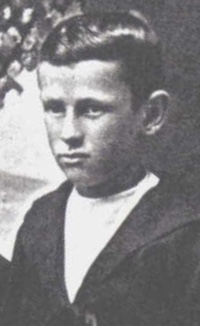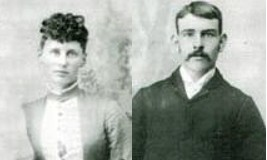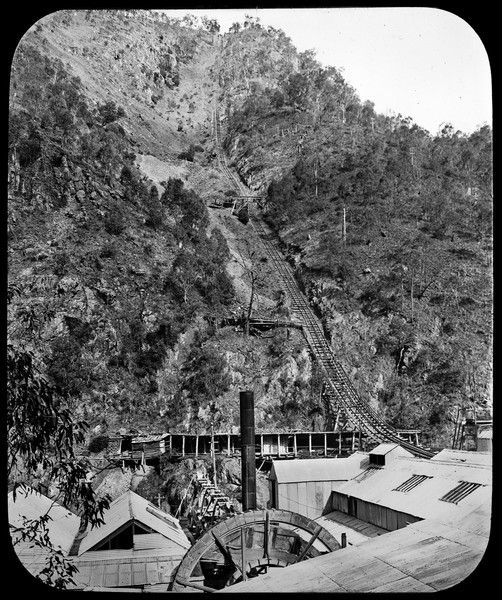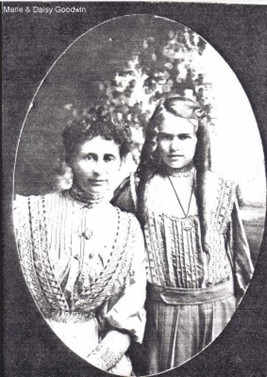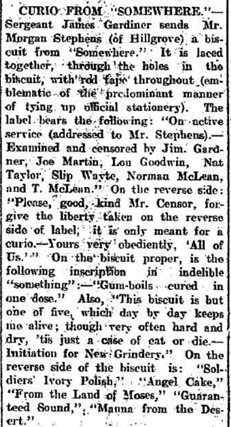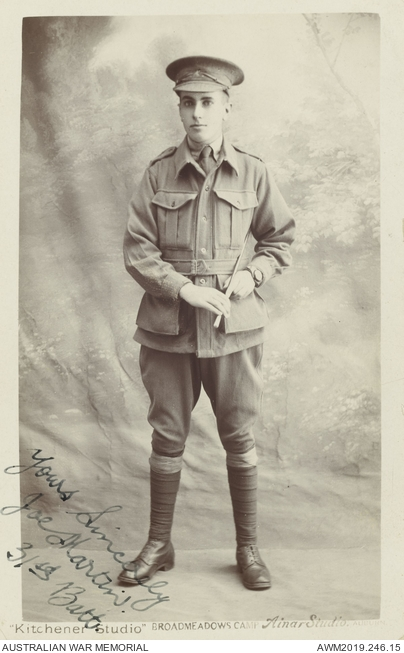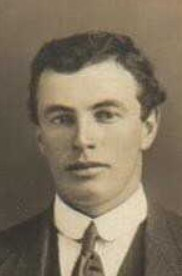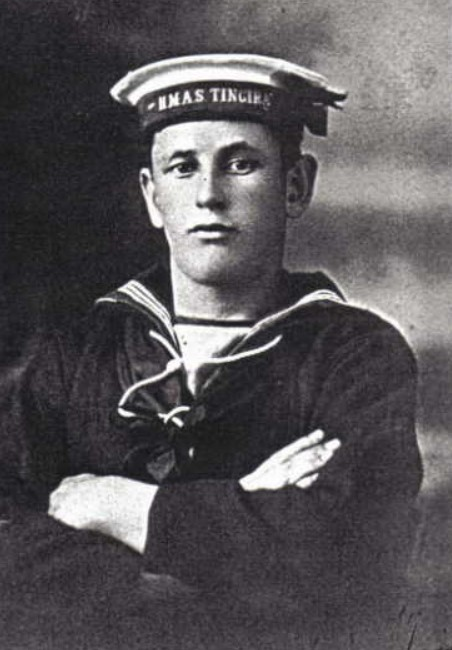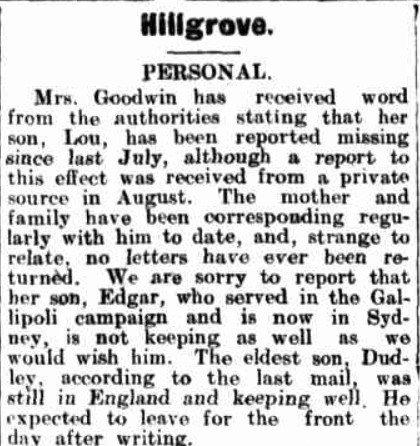Louis John GOODWIN
Eyes brown, Hair fair, Complexion fair
Louis Goodwin – Hillgrove Friend and Mate
Can you help us identify Lou?:
Private Louis John Goodwin, known as Lou, was killed in action on 17 July 1916 during a night patrol ahead of the Battle of Fromelles. His body was seen lying in No-Man’s-Land by his comrades, but it could not be recovered. He has no known grave.
Despite several witness reports and strong circumstantial evidence, Lou has not yet been formally identified. His name is commemorated on the Villers-Bretonneux Memorial in France.
Early Life
Lou was born in 1896 at Red Range, near Glen Innes in northern New South Wales. He was the youngest child of Albert Emmanuel Goodwin 1867-1897 and Annie Marie Kneipp 1866-1943, and grew up alongside his siblings Dudley, Huntley, James, Edgar, Daisy, and Aubrey. The Goodwin ancestors came from Kent. Kneipp family were from the Armidale area, their ancestors from Winkel, Hesse, Germany.
His early life was marked by tragedy. In January 1897, when Lou was still an infant, and Aubrey on the way, their father Albert was killed in a horrific mining accident at the Eleanora Mine in Hillgrove. While working in a shaft, Albert was struck in the back by a falling timber from 175 feet above. Though alive when brought to the surface, he died within minutes of his rescue:
He was struck just below the shoulder blades… the shaft of which had to be removed with a saw… he arrived still bleeding but beyond all doubt dying rapidly… he died almost immediately afterwards.
The Goodwin children:
- Dudley, Gordon, 1889-1962
- Huntley Dalton, 1890-1927 m Lurline Baker
- James, b 1891 - unknown
- Edgar , 1893-1943
- Daisy Mabel , 1894-1983
- Louis John , 1896-1916 Fromelles
- Aubrey Emmanuel, 1897-1989 m Ellen Kate Keneally
Annie Marie, widowed with five children and one on the way, continued to live in Hillgrove, a small but busy and thriving mining town. The town would have stood by her after the terrible accident. And she was very active in the community, hospital and the church. The children were educated at St Joseph’s Convent School. (Founded through Mother Mary McKillop’s sisters of St Joseph. Annie Marie would have met her when she visited in the late 1890s.)
When Lou left school, he entered the Public Service. In 1913, at just 17, Lou was promoted from a Telegraph Messenger in Hillgrove to a Postal Assistant (Grade II) at Jones Island, near Taree:
"Promotion: Louis John Goodwin, telegraph messenger, grade I., Hillgrove, to be postal assistant, grade II., Jones’ Island."
By 1915, with war raging overseas, Lou made the decision to enlist in the AIF. Like many young men of his generation, he was eager to serve — despite the personal risks, and the sacrifice his family had already endured.
Off to War
Lou enlisted in the Australian Imperial Force on 28 October 1915 at Armidale, New South Wales, aged just 19.
He was assigned to the 31st Battalion, 3rd Reinforcement and began his military training at Enoggera Camp in Queensland. On 18 February 1916, Lou embarked from Melbourne aboard HMAT A70 Ballarat, bound for Egypt. After arriving in Suez in late March, he was briefly confined to barracks and forfeited six days’ pay for a minor absence without leave — an infraction common among new recruits adjusting to the discipline of army life.
Before his death at Fromelles, Lou was part of a tight-knit group of local Hillgrove boys serving overseas. Their bond — and their humour — travelled with them into the trenches of France. In July 1916, Morgan Stephens of Hillgrove received a remarkable "souvenir" in the mail, a hard army biscuit, laced with red tape, and signed by several local soldiers including Louis Goodwin. The biscuit was inscribed with phrases like:
“This biscuit is but one of five, which day by day keeps me alive; though very often hard and dry, 'tis just a case of eat or die.”
It was labelled as “Soldiers’ Ivory Polish”, “Angel Cake”, “Guaranteed Sound” and “Manna from the Desert”. The humorous note was censored and signed by Lou himself, along with Jim Gardner, Joe Martin, Nat Taylor, Slip Wayte, and the McLean brothers — all from the Hillgrove region:
“Please, good, kind Sir Censor, forgive the liberty taken… it is only meant for a curio — Yours very obediently, ‘All of Us.’”
This small artefact reveals something deeper than humour — the resilience and spirit of a group of young men who faced the horrors of war with wit, loyalty, and connection to home.
On 1 April 1916, Lou was formally taken on strength by the 31st Battalion while at Duntroon Plateau, and just two months later, on 16 June, he sailed from Alexandria with the British Expeditionary Force to join the war on the Western Front.
Before embarking for France, Lou spent several weeks in Egypt with his battalion. It was during this time that Sergeant James Gardner, also from Armidale, wrote a letter home to the Armidale Chronicle, dated July 1916, providing an update on familiar faces:
Saw Tich Lawrence and his brother, also young Gallegos, my boy Allan, Joe Martin, Lou Goodwin, Nat Taylor, and Morris (from Hillgrove). All are well.
He closed the letter with the wry observation that they would soon be off to "the land of champagne and Eau de Cologne" — a nod to the move from Egypt to France that was already underway. After landing in Marseilles, France, on 23 June 1916, the men of the 31st Battalion travelled north by train and were stationed near the quiet town of Fleurbaix. It was here, in the trenches of northern France, that Lou would spend his final weeks.
The Lead Up - The Night Patrol – 17 July 1916
On the night of 17 July 1916, two days before the main assault at Fromelles, Lou Goodwin of A Company, 31st Battalion, was one of six men chosen for a dangerous reconnaissance patrol. Their mission was to cross into No-Man’s-Land near Fleurbaix under cover of darkness and inspect the German barbed wire entanglements. The purpose was to assess whether the wire had been effectively cut in preparation for the attack scheduled for 19 July.
It was a perilous task. The patrol had to crawl out into exposed terrain between the trenches, avoiding enemy observation, flares, and machine-gun fire. According to numerous witnesses, Lou did not return.
Private G. Holmes, 31st Battalion, A Company:
“Goodwin was picked with five others to go out and investigate to ascertain if the German wire was out… He did not return… Later, in hospital, it was reported that some of the chaps came across Goodwin’s dead body in the big charge on 19th and 20th July.”
Corporal Forbes, 31st Battalion:
“A party of which he and Goodwin were members went out to inspect German wires at Fleurbaix. Several of them were wounded, but all got back except Goodwin.”
Private C.C. Holmes, 31st Battalion:
“Corporal Lane told Frank Moorhouse that Goodwin had been killed and that he, Lane, had felt him and made sure he was dead before leaving him.”
Lance Corporal C. Bayliss, 31st Battalion:
“I saw the body myself from our first line trench and there was then no sign of life.”
Private W. McDougall, B Company:
“He was shot and so badly wounded he couldn’t manage to crawl back as they did.”
Pte S.G. Hodges, A Company:
“A pal of his, John Howard… told me that Goodwin had been killed on patrol… Howard tried to fetch the body in but was not allowed to.”
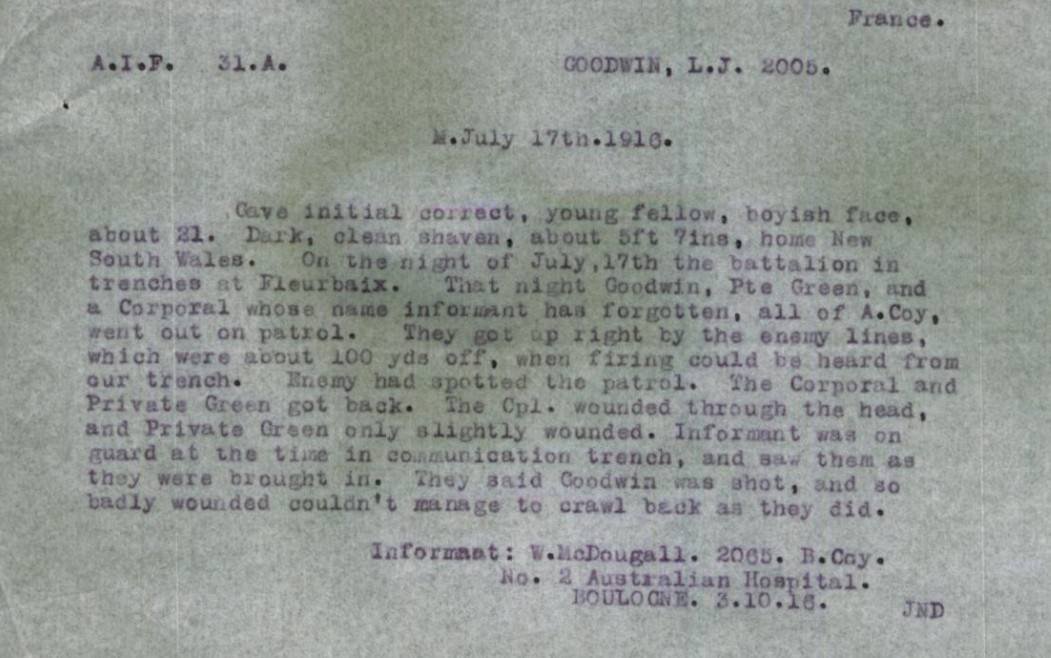
These statements all point to a single conclusion: Lou was killed during the patrol and his body was seen, touched, and confirmed dead in No-Man’s-Land. Several witnesses expressed regret that they could not retrieve him due to the danger. Despite the visible position of his body, no recovery effort was launched that night or the following day. This was common in that sector — venturing into No-Man’s-Land in daylight or without covering fire was a near-certain death sentence. And with the full-scale battle only 36 hours away, priorities had shifted to the main attack.
A year later, a Court of Enquiry held on 1 August 1917 officially declared Private Louis John Goodwin killed in action on 17 July 1916.
Form B103 simply states “Buried in the vicinity of Fleurbaix, Sheet 36NW.” His body was never recovered.

Fromelles
Despite extensive efforts by his mates and fellow soldiers, Louis John Goodwin never returned from the battlefield. His body was not recovered, but multiple eyewitness accounts confirmed his death and one report stated they came across his body on the night of the battle. Private John Lowe, 2190, of A Company, 31st Battalion, gave this report to the Red Cross:
“He was in A Company, and we shared the same tent. We were in the front line at Fleurbaix, and he was picked with five others to go out and investigate to ascertain if the German wire was out… He did not return, and Jack Howard went out to see if he could find him… Corporal Lane, who was one of the picked six, reported… that as he crawled back wounded, he came across Goodwin lying, and touched him, but got no reply. Lane was of the opinion that Goodwin was dead… Later on in hospital it was reported that some of the chaps came across Goodwin’s dead body in the big charge on 19th and 20th July, 1916.”
“Sergeant McKay told me in England that he had seen Goodwin’s brother, who was satisfied that his brother was dead.”
Two days after Lou was killed during the night patrol, the 31st Battalion took part in the Battle of Fromelles, launched at 6.00 PM on 19 July 1916. It was their first major action on the Western Front — and it ended in disaster. The battalion was tasked with assaulting heavily defended German lines across open ground, facing well-prepared machine-gun emplacements and largely uncut barbed wire.
The Australian 5th Division, which included the 31st Battalion, suffered over 5,500 casualties in 24 hours. The 31st Battalion alone lost 544 men killed, wounded or missing — more than half its fighting strength. Among the missing were many who, like Lou, were last seen lying in No-Man’s-Land, their bodies never recovered.
Friends killed in action
Lou did not go to war alone. On 28 October 1915, he enlisted at Armidale alongside two close friends from Hillgrove: Joseph Archibald Lorraine Martin and William Henry Logan. All three were young, local, and eager to serve — a reflection of the patriotic spirit that swept their small mining town.
They trained together, embarked on the same ship (in Lou and Joe’s case — the Ballarat), and corresponded with family and friends back home. They were remembered fondly by those who knew them — humorous, loyal, and brave.
Sadly, none of the trio would return:
- Private Louis John Goodwin was killed in action on 17 July 1916 during a dangerous night patrol near Fleurbaix. His body was never recovered.
- Private Joseph Martin (31st Battalion), was killed in action on 20 July 1916 during the Battle of Fromelles. Witnesses later recalled he was hit by a bomb or shrapnel and never seen again. He, too, has no known grave, and is commemorated at VC Corner, Fromelles.
- Private William Logan (3rd Machine Gun Battalion), survived longer than his friends. But on 30 September 1917, he was killed in action in Belgium during the Ypres campaign. He is remembered at the Menin Gate Memorial in Ypres, alongside thousands of others with no known burial place.
In October 1917, the Daily Observer described the tragedy:
“A sad feature of the death of Pte. W. Logan, of Armidale, is the fact that he was the last of three mates, who enlisted together from Hillgrove. The other two were Privates Lou Goodwin and Joe Martin. The whole of this gallant trio have died for their country”
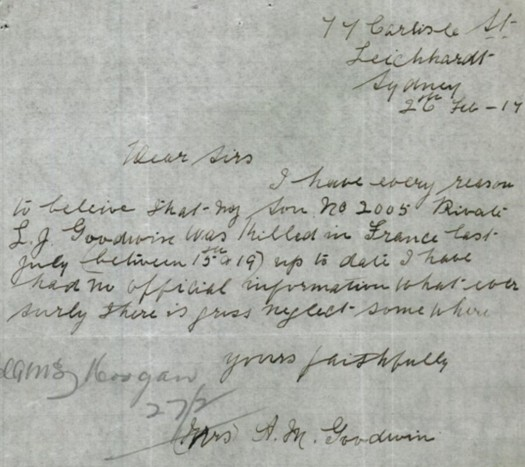
In March 1917 Annie Marie had moved to live in Leichardt, Syndey, In 1930 she was living with some of her children Daisy, a public servant, Dudley, an agent and Edgar a mechanic at 7 Esher St Burwood. In the same year, Aubrey is an orchardist in 598 Beelbangers, Griffith NSW.
A Family That Served
The Goodwin family gave more than one son to the Great War. While Lou was the only one who did not return, three of his brothers also served their country with distinction across multiple branches of the Australian forces:
- Edgar Goodwin (1892–1943) enlisted in the AIF on 2 March 1915 and served with the 7th Light Horse Regiment. He embarked from Sydney aboard HMAT Uganda in June 1915. After serving in the Middle East, he returned to Australia in January 1916.
- Huntley Dalton Goodwin (1890–1927) enlisted on 2 October 1917 and served as a Private in the Australian Army Medical Corps (AAMC). A grocer by trade, Huntley was born in Glen Innes and lived in Leichhardt. He survived the war but died young, aged just 36.
- Aubrey Emanuel Goodwin (1897–1989) joined the Royal Australian Navy in 1912 and served aboard HMAS Melbourne (I) during World War I. He later became an orchardist and lived into his nineties, passing away in 1989.
Aftermath
In March 1917, many months after Lou was reported missing, the Armidale Chronicle published a brief community update from Hillgrove. It described the ongoing uncertainty his family faced:
“Mrs. Goodwin has received word from the authorities stating that her son, Lou, has been reported missing since last July, although a report to this effect was received from a private source in August. The mother and family have been corresponding regularly with him to date, and, strange to relate, no letters have ever been returned.”
The article also noted that Edgar, recently returned from Gallipoli, was unwell in Sydney, while Dudley, the eldest, was in England awaiting deployment to the front.
Lou has no known grave, but his name is among the 10,885 Australians inscribed on the Villers-Bretonneux Memorial in France — a site that honours those who fell on the Western Front and were never recovered. The memorial stands on Hill 104, behind the Villers-Bretonneux Military Cemetery.
He is honoured on several other memorials, including:
- The Australian War Memorial Roll of Honour, Panel 118
- The Armidale Memorial Fountain, his regional war memorial
- The Sydney General Post Office (GPO) – Post Master General’s Department Honour Roll, recognising his work as a postal assistant
Can You Help Us Identify Lou?
Private Louis John Goodwin was killed during a night patrol on 17 July 1916, ahead of the Battle of Fromelles. His death was confirmed by multiple eyewitnesses who saw or touched his body in No-Man’s-Land, but he was never recovered. He has no known grave.
We are now seeking DNA from relatives to help confirm his identity and give him a named grave. Can you help?
DNA samples are being sought for family connections to
| Soldier | Louis John Goodwin (1896–1916) |
| Parents | Albert Emmanuel Goodwin (1867–1897) and Annie Marie Kneipp (1867–1943) |
| Siblings | Dudley Gordon Goodwin (1889–1962) | ||
| Huntley Doulton Goodwin (1890–1927) m. Lurline Baker | |||
| James Goodwin (b. 1891, died in infancy) | |||
| Edgar Goodwin (1893–1943) | |||
| Daisy Mabel Goodwin (1894–1983) | |||
| Louis John Goodwin (1896–1916) – Fromelles | |||
| Aubrey Emmanuel Goodwin (1897–1989) m. Ellen Kate Keneally |
| Grandparents | ||||
| Paternal | Benjamin Goodwin (1819–1893) and Rosannah Smith (1825–1899) – Kent, England | |||
| Maternal | Johann Baptist (John) Kneipp (1831–1914) and Caroline Utz (1842–1924) – Winkel, Hesse, Germany |
Links to Official Records
Seeking DNA Donors

Contacts
(Contact: carla@fromelles.info or geoffrey@fromelles.info).
(Contact: army.uwc@defence.gov.au or phone 1800 019 090).
Donations
If you are able, please contribute to the upkeep of this resource.
(Contact: bill@fromelles.info ).
